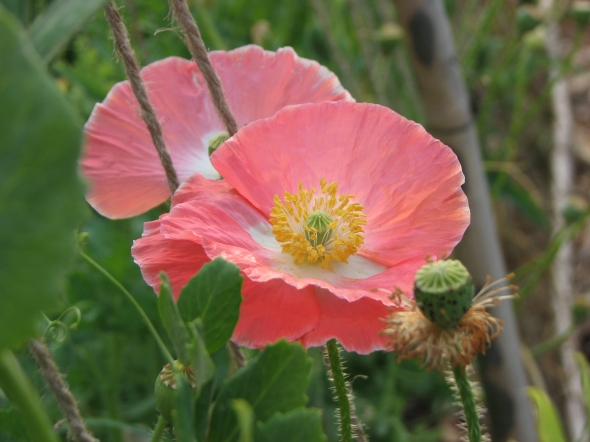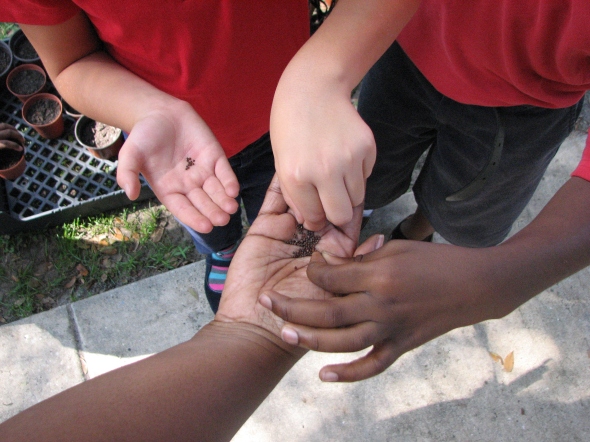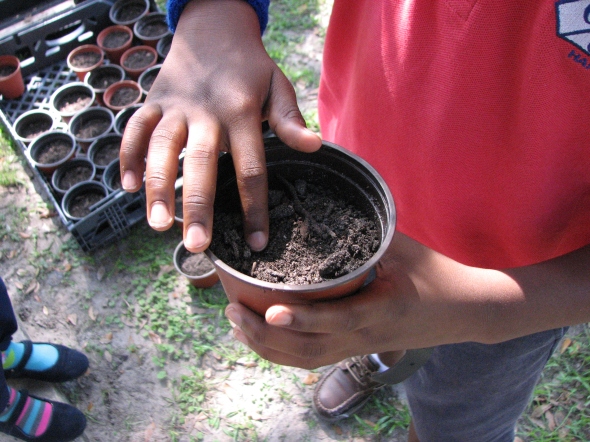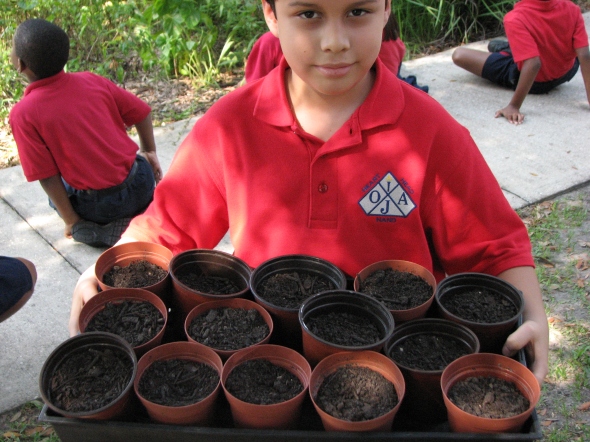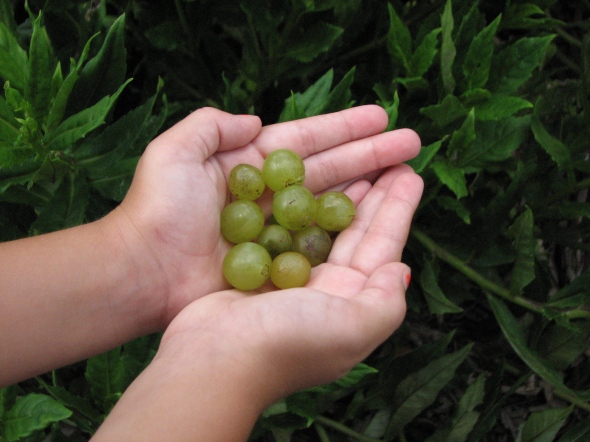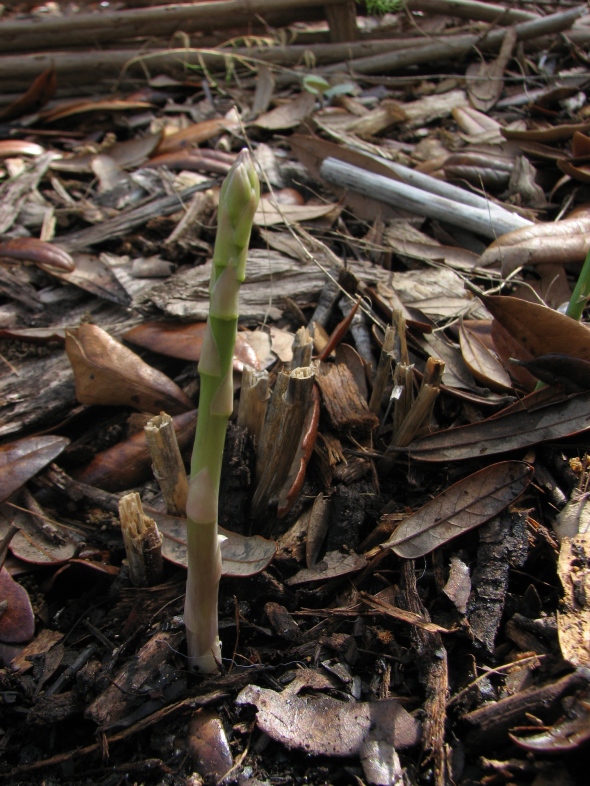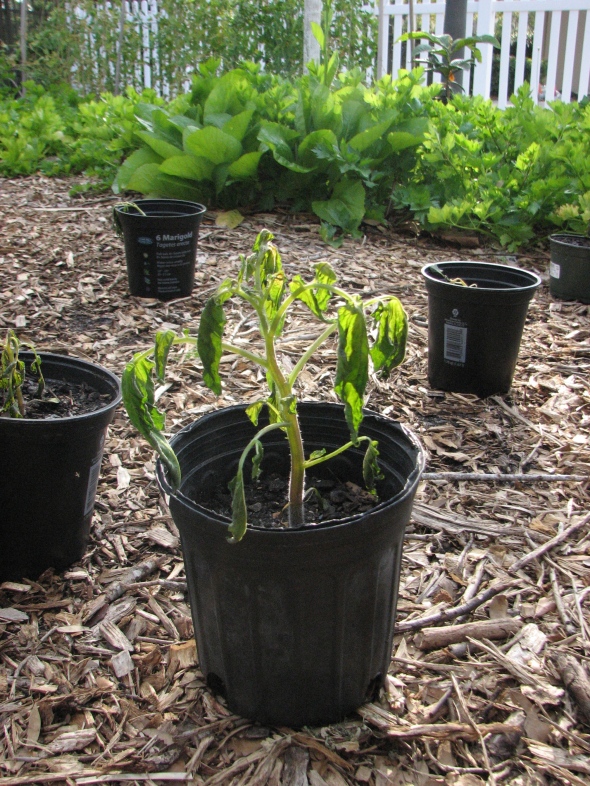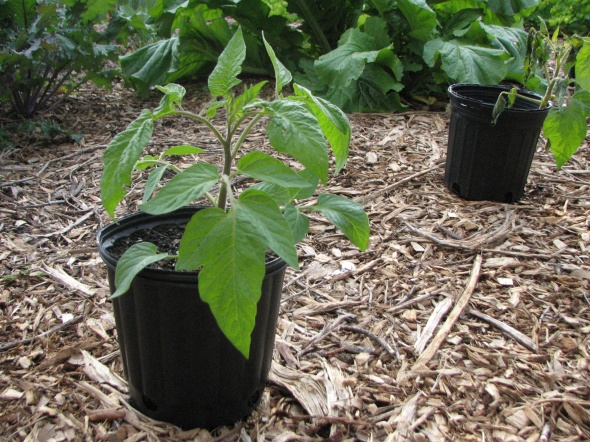Following Through

It’s not surprising that many of life’s most valuable lessons only get half learned. It is simply too easy to divert to a different path rather than follow anything to it’s conclusion. Never have there been so many forks in life’s road. Food lessons are no different. The term “seed to plate” may be on the verge of being overused to the point of meaninglessness but it’s philosophy, which challenges our short attention span, is just beginning to get traction. Looking at the food on our plates and tracing that food’s path back to a point of origin (soil) can be mind boggling. For some, even considering that journey is an epiphany. School gardens not only encourage kids to think about that journey, they invite them to embark on it. By planting a seed and committing to its growth, students learn first hand what it means to bring food to the table. For some foods, a “seed to plate” experience isn’t that much of a challenge. Cherry tomatoes are pretty easy except that many don’t even make it to the kitchen, much less a plate. Some foods require a bit more tenacity. Our last post covered the wheat grown by Mrs. Madrid’s first graders. This morning some of that wheat was finally ground into flour and made it to the plate in the form of pasta.
(Full disclosure: Much of our wheat is still green and not quite ready to harvest and Friday is the last day of school. Bummer. So even though we harvested some of our grain and included it in our recipe, our ingredients were supplemented by a bag of spelt berries.)
These first graders KNOW now what it takes for a seed of wheat that they planted in the fall to wind up as pasta on a plate in the spring. They have imagined it, seen it, smelled it, touched it, and this morning, tasted it. And it was good. All of it.
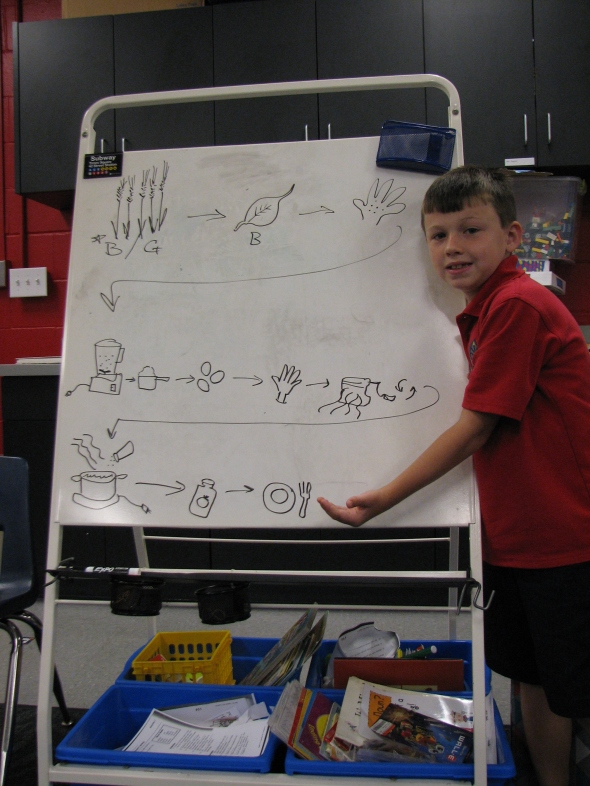
Our visual plan

Harvest

Threshing on a small scale

Gathering basil for the pasta and flowers for the table.

Preparing the “Volcano”

Kneading

Pasta machine
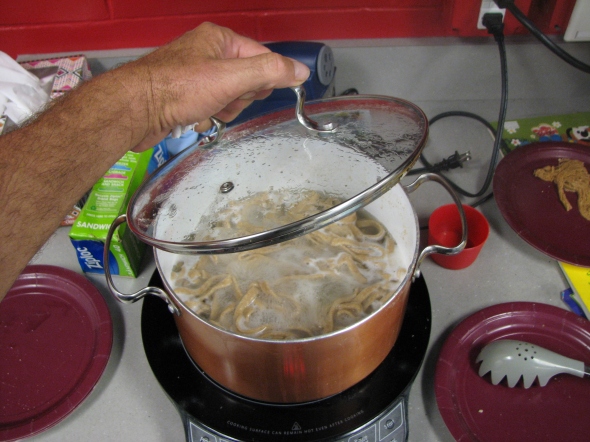
Almost ready

Yum.
Delayed Gratification
Encouraging students to strengthen and stretch their anticipation muscles is one of the primary functions of a school garden. Nature’s gratification is rarely instant but positive experiences in a garden, over time can provide a gratifying sense of accomplishment and satisfaction that is rarely equalled. This can also build patience. Everyone loves a patient child (or adult for that matter) but building patient children is difficult work. It is a delicate balance of challenging students just a bit beyond their comfort, but not so far beyond it that they lose heart and give up.
In the case of Mrs. Madrid’s winter wheat, we almost pushed it too far. From a first grader’s perspective, the time between Halloween and Mother’s Day nears eternity, but this is about how long it took for our winter wheat to reach maturity. Keeping first graders interested in watching grass grow for seven months was no small feat. Mrs. Madrid persevered. On a consistent basis this patience building teacher led her class out to the garden to observe and celebrate the slightest development. Even more frequently she sent two students out to water and report back to their classmates. Occasionally she accompanied her friends out to the garden just for a fresh air reset. Regardless, she was always encouraging these children that yes, in time, the harvest would come. And now…. finally… it has. Now, the possibility of pasta from scratch, from serious scratch is at our fingertips.
Maybe it’s a little cruel to make kids wait so long, (We definitely will add more faster growing plants to the first grade syllabus next year.) but they did it. They waited. They cared. They didn’t lose interest. They were patient. And soon, (very soon) spaghetti will never have tasted so good.

Kitchen House Update
Horizons are often difficult to judge. Sometimes things that seem far away turn out to be just over the next hill while other things that seem to be right at hand wind up being miles away. So it is with time. A deadline that seemed an eternity away is suddenly tomorrow and an idea that appeared so far away, surprisingly pops up into view. The Edible Schoolyard at OJA is experiencing just such: an exciting, long awaited, sudden development. Our team has long believed that our student’s cooking experience could be greatly improved by providing them with a true kitchen classroom. We have felt that the surrounding community might also enjoy this “seed to table” experience. We had faith that there were others who share our belief in edible education and would partner with us to create a vision of something new. This vision is quickly coming into focus in the form of a “kitchen house” and “give back garden”. An idea that once seemed “miles away” is suddenly on our doorstep. Through generous partnerships with Florida Hospital for Children and the Emeril Lagasse Foundation, we are creating an innovative space where students will be given the opportunity to learn about the source of their food. These students will also have a hand in growing and preparing that food, which we believe will inspire a healthier and more delicious lifestyle. Here are some architectural renderings provided by our design team partners, Midtown Architecture Studio and Hunton Brady Architects. 

 Since this project lies on a plot of land across the street from the school our students will not be the only ones able to utilize this facility. Other schools will be invited to enjoy this space as a field trip destination without any compromise to our own campus routine.
Since this project lies on a plot of land across the street from the school our students will not be the only ones able to utilize this facility. Other schools will be invited to enjoy this space as a field trip destination without any compromise to our own campus routine.
Tempis Fugit
Time runs from us. It usually takes off in a sprint while we’re looking the other way. Moments quickly pass through our fumbling fingers and we rarely take notice. We’re drawn to details that seem permanent and ageless because they help distract us from the uncomfortable ticking clock. In reality though, building our lives around this distraction is a trap of denial. You can’t stop that clock, no more than you can stop that beautiful sunset. Ironically, part of what makes that sunset so great is that it runs away and doesn’t last. It’s unfortunate that we sometimes associate the temporal with the disposable. We question the value of things that don’t last. In our disposable culture that’s usually a reasonable question, but a sunset is not a paper plate. A melting snowflake is not a plastic fork. The natural world is full of the temporal that calls our attention to time not away from it. For some, the seasons are a drastic reminder of how nature seems to celebrate time. Floridians, however, have to look a little closer. So much of our landscapes here have been designed to appear unchanging. While pursuing the holy grail of the “maintenance-free yard”, we have wound up with an environment that looks pretty much the same in January as it does in July. What a shame. The passage of time should be celebrated. Poppies can help. They don’t last. Look the other way and you’ll miss the party.
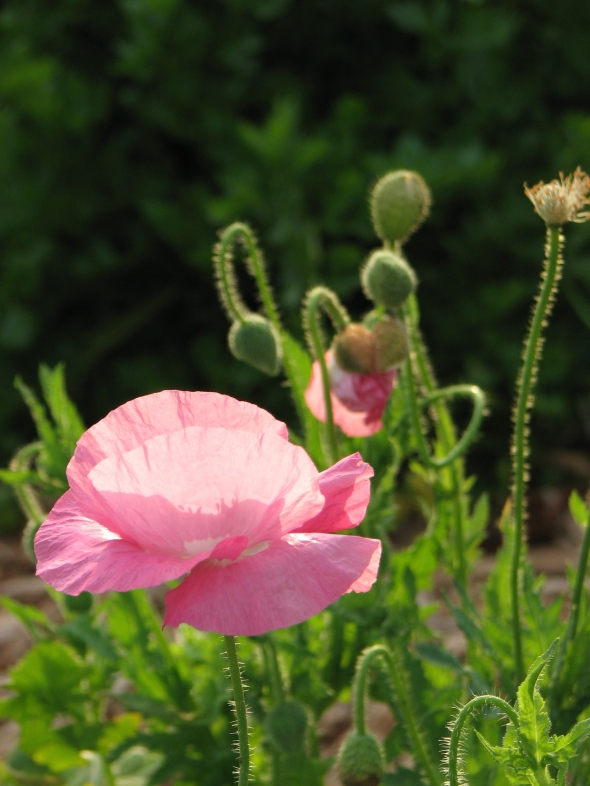
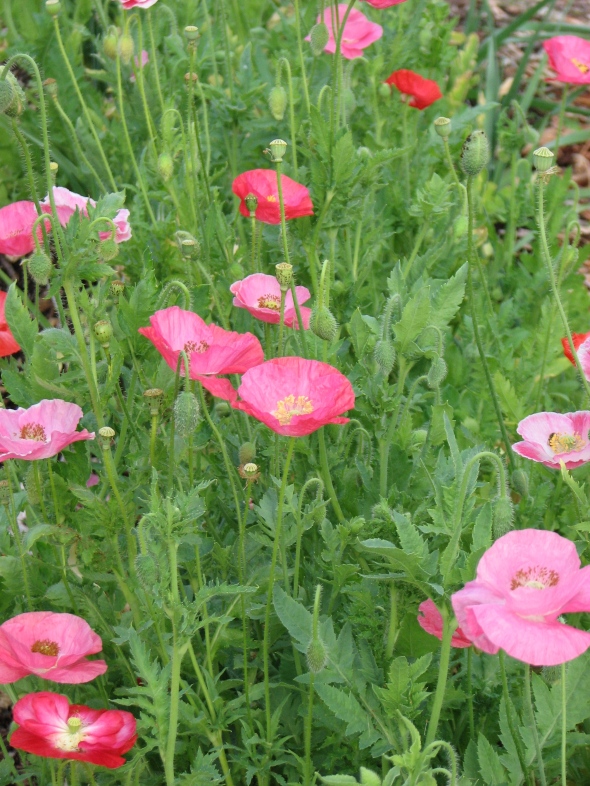 Scatter poppy seeds in the Fall and you’ll notice when Spring arrives.
Scatter poppy seeds in the Fall and you’ll notice when Spring arrives.
Yes, There was pie.
Two small pumpkins from our garden became pumpkin pie for our kindergarteners this week. Most of the journey from seed to pie plate happened right outside their classroom door. These students can tell you about this journey by what they’ve seen, what they’ve touched, what they’ve smelled, and yes what they have tasted.
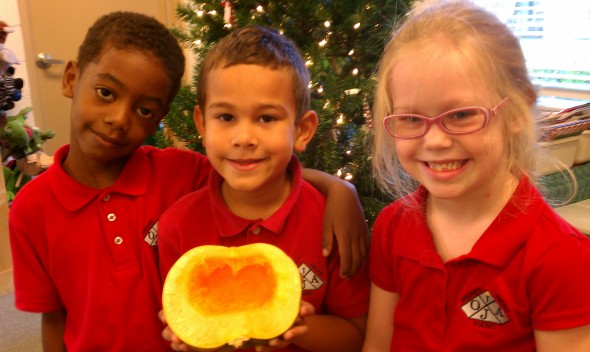 Though the pumpkins were pretty small, the impact they had on pie appreciation was pretty big. Pie just tastes better when you’ve been waiting for it since August.
Though the pumpkins were pretty small, the impact they had on pie appreciation was pretty big. Pie just tastes better when you’ve been waiting for it since August.
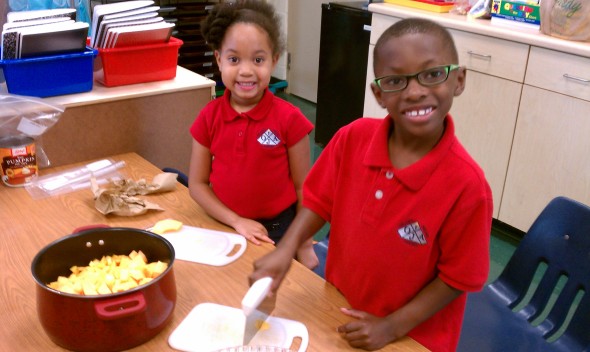 It also tastes better when you help make it.
It also tastes better when you help make it.
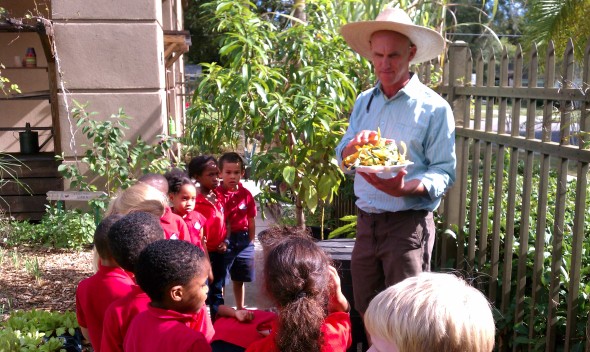 Everyone was OK with letting the worms in our composter have the pumpkin scraps.
Everyone was OK with letting the worms in our composter have the pumpkin scraps.
Seed Planting Blitz
Of course the clock is ticking. It’s always ticking. It just seems that this time of year the ticking gets louder when you realize that winter is coming. Obviously, most of the country will scoff at Floridians who use the word winter to describe the months of December through March and in this heat those Floridians will have a hard time even remembering what winter is. Their memory will be compromised in fevered brains as they try to navigate the delirious summer haze of the Target parking lot without having a stroke. It’s easy to forget about frosty mornings when the daily rainstorm has left the asphalt literally steaming. Nevertheless, frosty mornings are coming and even cold hardy crops need to be established before it gets cold. Therefore, we’re planting seeds and we’re planting lots of them.
Tick Tock!
On your mark, get set…….
Here we go again. The first day of school is a new verse to a very old song. Pencils are sharpened. The walls have a fresh coat of paint. There may even be 64 crayons in the box. It all seems so new,….. but is it really? Yes and no. The thrill/terror of entering a new classroom on the first day is anything but new. OJA has been doing this for a while and has had over one hundred “first days”, each with its share of excitement. Because of this, Monday won’t really be the first day of school. It won’t be new…. and yet it will be. It will be “new” because it’s a long first walk from the car to the classroom for many of our students (and an even longer walk back to the car for many of our parents) “New” is a big deal. There’s been a palpable buzz on campus as teachers have prepared their classrooms because “new” is a big deal. Even the eighth graders, who have been here for a while, recognize Monday’s importance because “new” is a big deal. It’s a new chance, a fresh start, a clean slate, but it is, again, an old school. It’s an old school with a rich culture, one that’s taken years to develop. Generations of parents, teachers, church members and friends have invested the resources that make OJA what it is today, a place where children are challenged and comforted, a place where excellence isn’t just expected it’s anticipated and celebrated, a place where students are loved. OJA is an old place that makes “new” a big deal.
It’s just like the garden. (Come on, you knew that was coming.) Now is the time to start our fall/winter garden with a seed planting blitz. It’s hard to look at a fresh plot of black soil raked smooth and not think: “clean slate” or hold a tiny seed between your fingers and not think: “brand new” or smell the rain and not think: “fresh start”. It all seems so new…. but is it really? The complex history within a handful of our garden soil could be discussed for days. The seeds that we plant are the inherited product of generations of farmers and gardeners who selected and saved seeds; each year planting only the best of the previous years crop. Even the rain has been through countless cycles of condensation and evaporation before falling on our patch. Gardens are old with a rich culture that’s taken years to develop. Children have been learning to grow food for a very long time, but anytime a child pulls their first carrot out of the ground the whole world seems brand new. Our garden isn’t new……but it is and “new” is a big deal.
On Fire for Education
What may appear, at first glance, as an emergency crisis is actually a well planned training exercise. Like Orlando Junior Academy, the Orlando Fire Department recognizes the value of hands-on experiential learning and was able to benefit last week by setting this old house ablaze. OFD has eighteen new recruits that were able to train in a “live fire” scenario in an actual residential structure, which is a rare and valuable opportunity. The house itself is located across the street from our school’s gymnasium and sits on a double lot. OJA owns this property and is looking to expand the current Edible Schoolyard program to address the needs of the greater community. Rather than simply bulldoze this building down, OJA realized it could be used for educational purposes by the fire department. Since it is OJA’s desire to be engaged in its community and partner with those who make that community a better (and safer) place to live, OJA agreed to let the fire department have free access. None of this would be possible of course, without the generosity of Florida Hospital and Brasfield & Gorrrie, who have agreed to support our Edible Schoolyard by removing what is left of the house and preparing the lot for future development. These are the kinds of partnerships that we see as being vital not only to the success of our school as an institution but to our graduating students as well. It is our hope that children leave OJA with the desire to be an integral part of their community, receiving graciously and giving generously, equipped and inspired to make a difference.
Promises, Promises
There are many aspects of gardening that encourage the development of patience. Gratification is hardly instant in food production. Rarely, however, are patience and restraint required to partner together so desperately as when dealing with the agony of growing asparagus. Fresh asparagus is certainly worth the square footage required to grow it and of course good soil and seeds are hardly a sacrifice. The time one must wait to actually eat it, however, is ridiculous. Most gardeners are ready to accept the fact that after the average vegetable seed is planted, there is no need to set the table for at least a couple of months. This flies in the face of our “fast food” culture but it’s doable. Asparagus on the other hand gives “slow food” a whole new meaning. If you’ve been reading this blog for awhile you may remember our students planting asparagus seedlings in our garden. Click here to read about it. Yes, that’s right, it’s been almost a year. To this date the amount of asparagus that’s been eaten or should we say “tasted” from that planting would not equal a single serving size. The goal with asparagus is to let each plant develop and grow to the size where it won’t miss a few shoots of new growth each spring. Asparagus is a perennial plant that, when mature, can produce for twenty years but it can take two or three years before it reaches maturity. Even worse is that while waiting for that to happen, these plants send up shoots that look like the one pictured above. You know it’s crisp. You know it’s juicy. You know it’s delicious. You know that asparagus is the vegetable of kings. You know you can’t have it.
Not yet.
D’ohh!!!!
For some reason (please feel free to explain in the comments section) a forecast predicting temperatures in the mid to upper thirties does not preclude a chance of frost. In the wee hours of Monday, morning Jack Frost decided to pay a visit to our garden. Fortunately, most of our winter crops were unfazed, however, many of our tomatoes and eggplants were traumatized and in some cases obliterated. What is really strange, though, is how the damage wasn’t across the board. Like a tornado that wipes out one house and leaves another across the street unfazed, frost found the plants that just happened to be in the wrong place at the wrong time. Sometimes just a few feet was the difference between “no damage at all” and “I think that slimy blob used to be a tomato plant.” Microclimates are real.
The embarrassing part is that the reason our tomato plants were in these pots to begin with was to prevent this very scenario. The upper grades have been discussing (at length) the “window of opportunity” that gardeners have to grow tomatoes successfully in Central Florida. They have learned that most tomatoes will not “set” fruit once temperatures consistently are above 85 degrees Fahrenheit. This wouldn’t be a problem, except that happens pretty early around these parts and as is painfully obvious; we can still get frost in February. This leaves precious little time to grow a plant that is big enough to produce flowers before it gets too hot. That’s why we start our tomato seeds in pots, so that we can get them going before Christmas. We leave them outside when its warm and bring them inside…. when … we ….uhm…have.. a…um, you know……. a frost.
Oh well, the reason we are doing this is to learn, right? At least grace was extended and we still have many survivors. We’ll be watching the local weather a bit more closely and will eventually put these lucky ones in the ground, that is after Jack Frost has left town for good.
Pumpkins’ Progress
Before
After
What a difference a month makes. Our Musque de Provence pumpkins are on a stampede.

